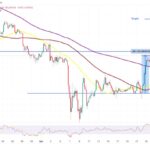In a striking development in the cryptocurrency landscape, a staggering transfer of over 3,520 Bitcoin, valued at approximately $330.7 million, has raised eyebrows in the industry. This suspicious activity, noted by blockchain investigator ZachXBT, is thought to be connected to a hack, particularly considering the immediate conversion of the Bitcoin into Monero (XMR), a cryptocurrency renowned for its privacy features. Monero obscures transaction details, making it an appealing choice for those looking to keep their activity under wraps.
The move to Monero, however, is noteworthy due to its limited liquidity on exchanges, which complicates transactions and exposes users to slippage—a situation where the final price of a transaction differs from the expected price. Unlike more liquid assets like Tether (USDT) or Ethereum (ETH), which would have made the transfer smoother, the choice to use Monero suggests a deliberate strategy, possibly linked to the need for anonymity or evasion of asset freezing.
“The unique mechanics of Monero transactions hint at something more complex than simple laundering,” ZachXBT noted.
Trading data highlights that the transaction wasn’t just a straightforward attempt to obscure stolen funds. In fact, the liquidity around XMR’s market depth was relatively shallow, resulting in potential losses of nearly $66 million due to price shifts in response to the large purchase. Interestingly, while Monero’s price surged by 45%, the open interest for XMR on major exchanges more than doubled, hinting at coordinated trading strategies at play. According to metrics from Coinalyze, the open interest reached $35.1 million, far exceeding expectations given the price movement.
This tactic of using illiquid assets to manipulate derivatives isn’t a novel one in the crypto sphere. Similar strategies were observed recently, such as a trader’s manipulation of JELLY prices on the decentralized exchange HyperLiquid. Drawing comparisons to a $114 million exploit on Mango Markets in 2022, these situations reflect a troubling trend of market manipulation in the ever-evolving landscape of digital currencies.

Suspicious Transfer of BTC to Monero: Key Insights
The recent movement of over 3,520 BTC to Monero raises numerous concerns and implications for the cryptocurrency ecosystem. Here are the key points to consider:
- Significant Transfer: Over 3,520 BTC (valued at $330.7 million) transferred to Monero, indicating possible links to a hack.
- Monero’s Privacy Features:
- Monero (XMR) provides untraceable transactions, obscuring both sender and recipient addresses.
- The illiquidity of Monero complicates smooth transactions, exposing users to the risk of slippage.
- Alternative Options:
- Stablecoins like Tether (USDT) or Ether (ETH) would have enabled smoother transactions with less slippage.
- Mixers like Tornado Cash could have obscured transaction paths while using more liquid assets.
- Market Impact:
- Transaction slippage could have cost the hacker up to $66 million due to Monero’s limited liquidity.
- XMR surged by 45%, reflecting the high volatility and manipulation potential in the market.
- Derivatives Market Activity:
- Open interest in XMR futures and options rose significantly, indicating a buildup of positions ahead of the price surge.
- Unusual increases in open interest contrasted with expected growth, hinting at potential market manipulation.
- Previous Manipulation Cases:
- Similar tactics were used in past incidents, such as the manipulation of JELLY prices on HyperLiquid.
- Notable past exploit on Mango Markets illustrates the recurring risk of price manipulation using borrowed assets.
Impact on Readers: Understanding these activities can help readers navigate the cryptocurrency markets more cautiously, recognizing the risks associated with low liquidity and market manipulation. It highlights the importance of thorough research before engaging in crypto transactions, especially in decentralized markets.
Monero’s Surge: Implications of a Massive BTC Transfer
The recent substantial transaction of over 3,520 BTC, equivalent to around $330.7 million, into the privacy coin Monero (XMR) sheds light on broader trends within the cryptocurrency landscape, particularly in derivatives trading and market liquidity. This move, linked to potential hacking activities, raises significant questions about market manipulation and the strategic use of illiquid assets.
While Monero offers enhanced privacy features by obscuring transaction details, which can be appealing to those looking to hide illicit activities, its inherent liquidity challenges can act as both an advantage and a barrier. Compared to more mainstream assets like Tether (USDT) or Ether (ETH), Monero’s limited liquidity means increased risk for those who wish to move large amounts of value without causing significant price fluctuations. The reported 45% surge in XMR’s price during the transaction hints at the market’s volatile nature, suggesting that traders may experience substantial slippage when converting, potentially leading to hefty losses—up to $66 million in this instance.
On the flip side, this environment may favor ambitious traders and entities with long positions in XMR, as they could leverage the surge for profit amidst the chaos. However, the complex dynamics also imply that such strategies are not without risks; the slippery slope of manipulating market prices could lead to regulatory scrutiny and operational challenges. The interconnected nature of illiquid assets in derivative markets poses dangers not just for the perpetrators, but for participants across the ecosystem.
Similar scenarios have unfolded before, as seen in past manipulations like the JELLY incident on HyperLiquid or the $114 million exploit on Mango Markets, where traders have employed dubious tactics to inflate prices and profit from derivative holdings. These incidents highlight a critical vulnerability for exchanges and investors alike, emphasizing the growing need for vigilance in monitoring unusual trading patterns.
In this evolving landscape, malicious actors could find new avenues for exploiting weaknesses in decentralized finance (DeFi) systems. As traditional traders become aware of these tactics, they may find it increasingly challenging to navigate markets that are prone to manipulation. In contrast, sophisticated traders—especially those familiar with derivatives—may find ways to capitalize on such fluctuations. The ongoing dance between regulation, market behavior, and technological advancement will be crucial in shaping the future of crypto transactions, especially involving privacy-centric coins like Monero.

















